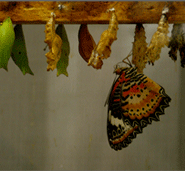How do we remember? Not with calendars or clocks. Certainly not with the eponymous temporal lobe.
We remember by looking at old photographs, their wear and tear telling time. We remember in a grandfather's waist belt that we no longer know how to wear or by the taste of fake sugar cigarettes that we couldn't smoke. We remember by tasting a spice used in biryani or by feeling the wee corners of our ears turn icy cold.
We remember by seeing a high rise building where a park used to be, we remember by carrying flashlights to the jungle at night with the childhood thrill of seeing a leopard look us in the eye. We remember often, a letter or a sweater or a book or word, and don't know why we remember, or where the source of the memory lay, but we remembered still.
Now, decontextualized, these memories lay lodged within us. We remember with the things that occupy our lives--Memorobilia--and their eventual metamorphosis into something else.
The first issue of The Fuschia Tree--an art storybook--has been inspired by a personal moment with a work of art that refuses to escape us.
Four writers tell stories of their encounters with art. The tone is, naturally, up-close and personal, the style is of a private conversation, the effect they have, thus, is rendering the reader as a voyeur into an intimate scene.
Noida Soliloquy tells a story of the strangeness of cities and the inspiration behind Dhruv Malhotra's photographs, whose "daylight-night pictures force us to look at the mundane in new ways".
Still Live/Live Still also interacts with photographs to show how they do not, in fact, exist in two dimensions, rather they "transmit the disembodied power of Performance through time".
Both 'Memories of Growing Up' and 'Incomprehensible' mould the medium of sculpture that redefines our sense of space, and therefore time.
To tell a story--through art, on art--is at the heart of Memory. A pyramid, a circle, a single dot, a line: whatever the arc might be, its characters, their eccentricities and the place they inhabit come alive-- and remain as memorabilia for the accumulation of future nostalgias.
Next week's issue explores performance art, its various contradictions, complexities, its corporeality, its temporality and ultimately, its ability to hold the mind and the body captive, then free it, in the heat of the moment and the peripatetic impulse afterwards.
So return to your childlike self, climb high up in a tree--with your iPad--and spend your Sunday reading.
Wishing you a slow read,
Himali.
Editor's Note.
Every sunbeam, every strain of music, every sapling and starfish is ultimately the regeneration of a previous something, a collection of somethings, taking on new shape. At the most indivisible level we can comprehend, all life is nothing more than atoms and molecules dancing their way through various forms. And if everything comes from something, it stands to reason that everything must go to something as well.
Read More
Illusion: Seeing Beyond Seeing
Meaning: In Search of Significance.
Melody: A Different Tune
Rhythm: Ordering Time


